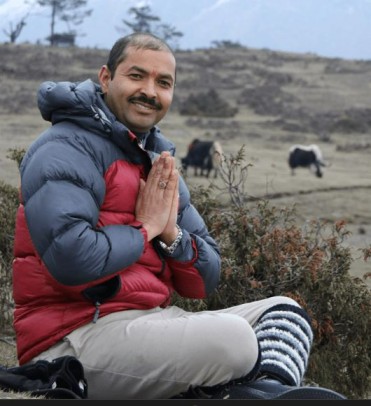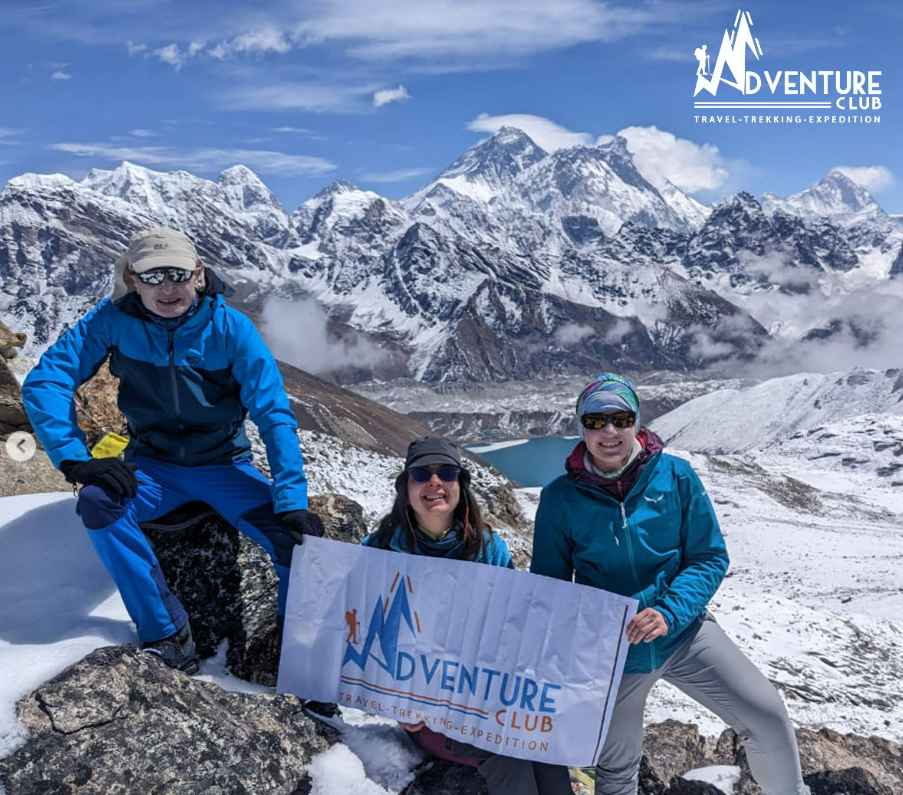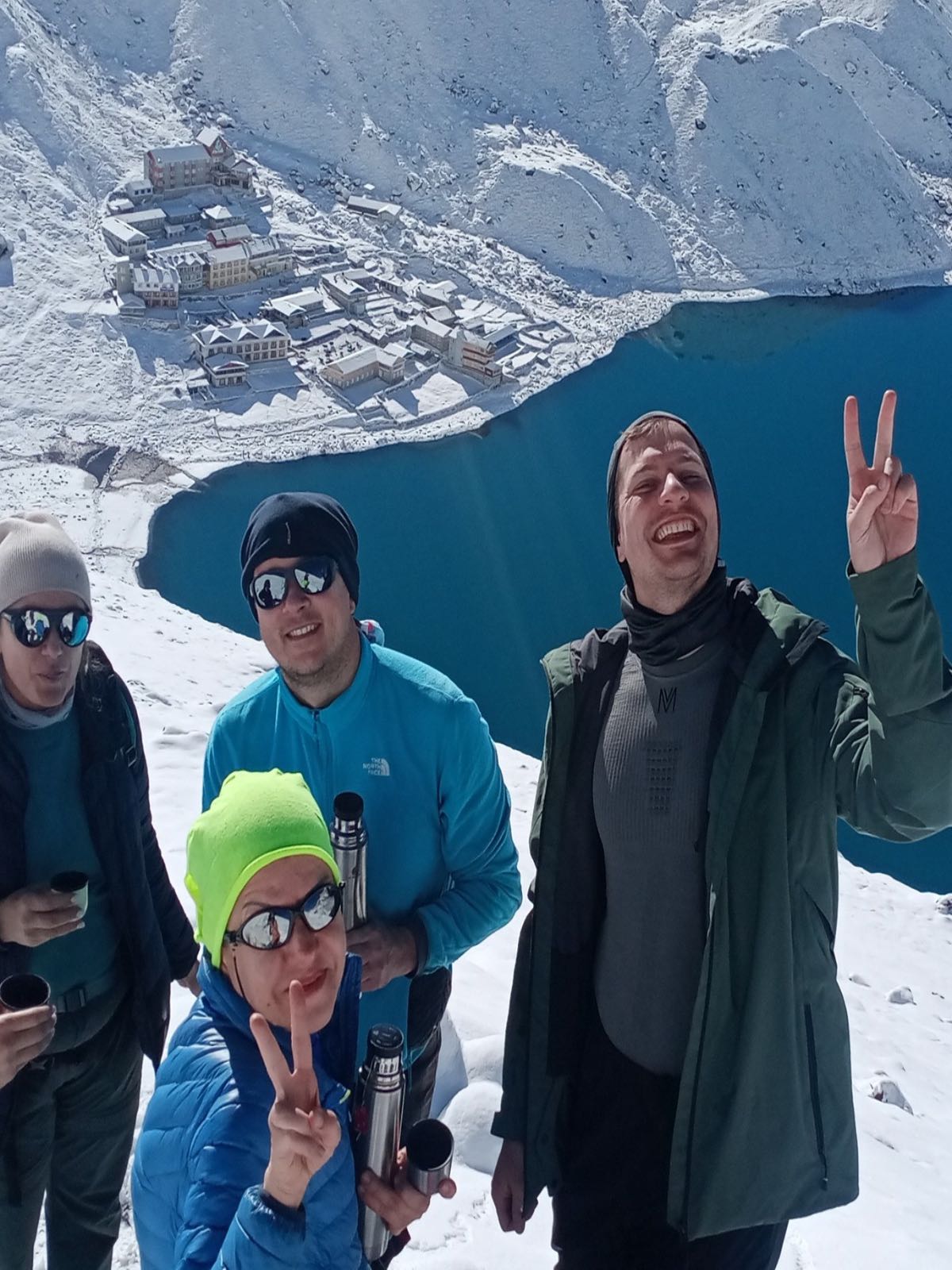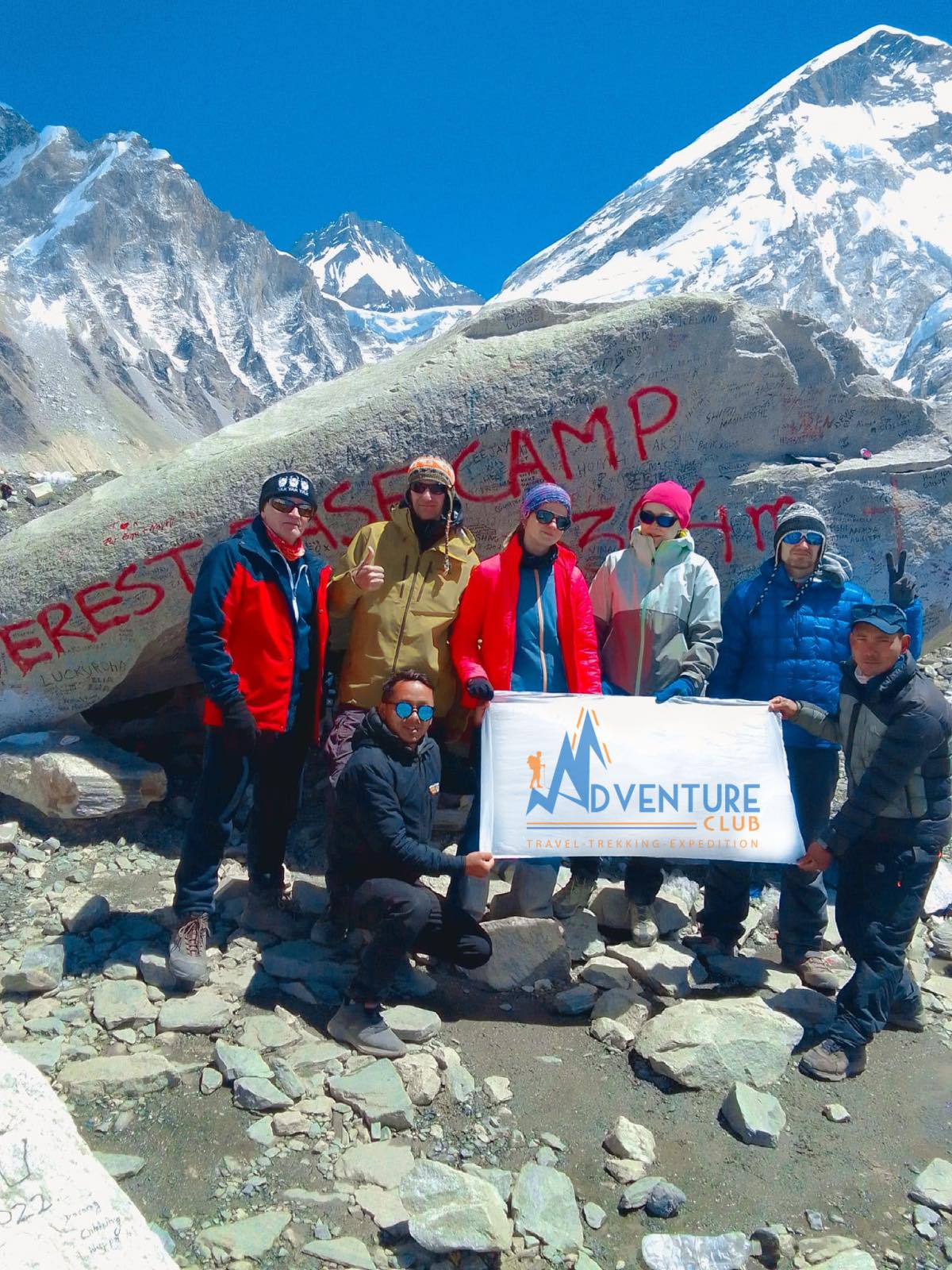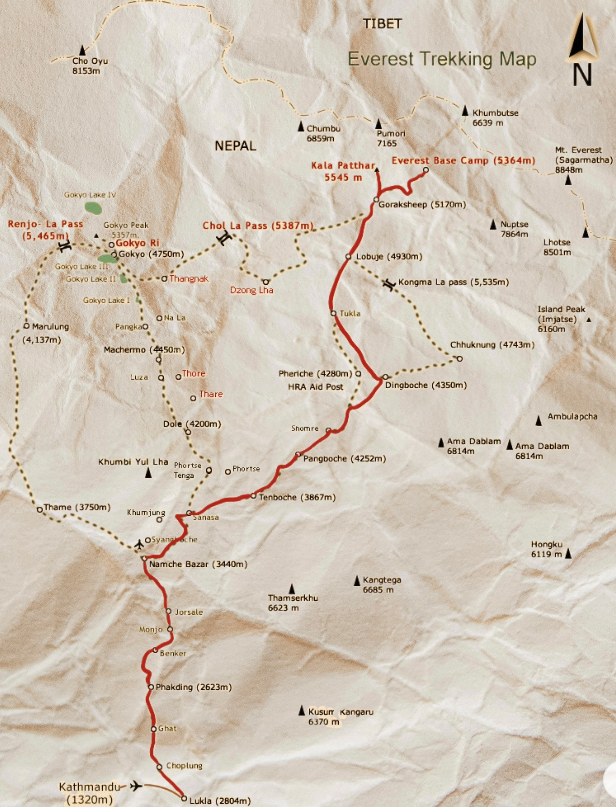At a Glance
15-18D
Challenging
2-18
Air-conditioned private tourist vehicle.
Trekking
Mar-May & Sept-Nov
Teahouses and Lodges
Overview
The Everest Base Camp Trek via Gokyo Lakes is an incredible journey that takes you through some of the most beautiful and remote regions of the Himalayas. This trek is perfect for those who are looking for a more challenging and off-the-beaten-path experience, as it takes you through the stunning Gokyo Valley and over the challenging Cho La Pass. Along the way, you'll have the opportunity to explore ancient Buddhist monasteries, visit traditional Sherpa villages, and take in some of the most breathtaking views of Mount Everest and the surrounding peaks.
The trek begins in the charming town of Lukla, where you'll embark on a journey that takes you through lush forests, across rushing rivers, and up steep mountain trails. As you gain altitude, the scenery becomes more and more breathtaking, with snow-capped peaks and glaciers looming on the horizon. You'll also have the chance to explore the stunning Gokyo Lakes, which are a series of high-altitude glacial lakes that are surrounded by towering peaks.
As you make your way toward Everest Base Camp, you'll pass through some of the most iconic locations in the Himalayas, including the Sherpa village of Namche Bazaar and the base camp itself. The final ascent to the base camp is a challenging but rewarding experience, as you'll be rewarded with some of the most spectacular views of Mount Everest and the surrounding peaks. With expert guides and comfortable accommodations, this trek is the perfect way to experience the natural beauty and cultural richness of the Himalayas.
Important Note:
Everest Base Camp Trek via Gokyo Lakes is a challenging trek that takes you through the beautiful Himalayan mountain range, passing through the Gokyo Lakes, and eventually reaching the base camp of the world's highest peak, Mount Everest.
Altitude: The trek takes you to a maximum altitude of 5,357 meters (17,570 feet) at Gokyo Ri, which is higher than the base camp itself. It is important to be aware of the risks of altitude sickness and to acclimatize properly before continuing to higher elevations.
Accommodation: Accommodation during the trek is primarily in teahouses and lodges. These are basic accommodations with shared bathrooms and simple meals. It is important to be prepared for the limited facilities and to bring your own sleeping bag and other necessary gear.
Culture and People: The trek takes you through the Sherpa communities in the Solukhumbu region. Sherpas are known for their strength, endurance, and expertise in mountaineering. They are also known for their hospitality and friendliness. It is important to respect the local culture and customs and to be mindful of the impact of tourism on the communities.
Itinerary
Day 1
Upon arrival at the airport in Kathmandu, you will be greeted by a representative from the Adventure Club who will assist you with your luggage and transfer you to your hotel.
After checking in, you will have a brief meeting with your guide who will give you a detailed overview of the trek and answer any questions you may have. You will also have the opportunity to check your equipment and make sure everything is in good condition before starting the trek.
Day 2
On Day 02, you will embark on a guided city tour of Kathmandu, where you will have the opportunity to explore some of the city's most important cultural and historical sites. The tour will begin with a visit to Swayambhunath Stupa, also known as the Monkey Temple. This ancient Buddhist temple is located on a hilltop overlooking the city and is one of the most important pilgrimage sites in Nepal. The temple complex is home to a large statue of the Buddha, several shrines, and a stupa that is believed to be over 2,000 years old.
Next, you will visit Patan Durbar Square, which is located in the heart of the city. This UNESCO World Heritage Site is home to several temples, palaces, and courtyards that date back to the 17th century. You will have the opportunity to explore the intricate carvings and architecture of the temples and palaces and learn about the history of the city.
After that, you will visit either Pashupatinath Temple or Baudhanath Stupa depending on the tour schedule. Pashupatinath Temple is one of the most important Hindu temples in the world, and it is dedicated to Lord Shiva, the Hindu god of destruction and regeneration. The temple complex is home to several shrines and temples, as well as a large statue of Lord Shiva.
Alternatively, if the tour is heading to Baudhanath Stupa, it is one of the largest and most important Tibetan Buddhist temples in the world. The temple complex is home to several shrines, statues, and mandalas, and it is a popular pilgrimage site for Tibetan Buddhists.
Day 3
Lukla is the starting point of your trek to Everest Base Camp. You will begin by taking an early morning flight from Kathmandu to Lukla, which is a small town located in the Khumbu region of Nepal. The flight is an exhilarating experience, offering stunning views of the Himalayas and the surrounding landscapes.
Upon arrival in Lukla, you will meet the rest of your trekking team and begin the trek to Phakding. The trail takes you through beautiful forests and along the Dudh Kosi River, offering great views of the surrounding mountains. The trek is relatively easy and takes around 3-4 hours to reach Phakding.
Phakding is a small village that is located on the banks of the Dudh Kosi River. It is the perfect place to rest and acclimatize before continuing on the trek. You will spend the night in a local teahouse, where you will enjoy a delicious dinner and get a good night's sleep.
Day 4
Day 4 begins with a trek from Phakding to Namche Bazaar. The trail takes you through beautiful rhododendron and pine forests, and along the Dudh Kosi River. You will cross several suspension bridges, and pass by small villages and traditional farming terraces.
As you continue on the trail, you will begin to see some of the first views of the Himalayas. The trek becomes steeper as you get closer to Namche Bazaar, and the trail takes you through a series of switchbacks known as the Namche Hill.
Upon arrival in Namche Bazaar, you will be greeted by the bustling market and the vibrant culture of the Sherpa people. Namche Bazaar is the gateway to the Everest region and serves as the main hub for trekkers and climbers. You will spend the night in a local teahouse, where you can explore the town on your own.
Day 5
On your day of the 5th is a rest day in Namche Bazaar, which is an important stop for acclimatization before continuing on the trek. The higher altitude can cause altitude sickness, and it is essential to take a day to rest and adjust to the new environment.
You can spend the day exploring the town and visiting the local markets. There are several shops selling trekking gear, souvenirs, and traditional handicrafts. You can also visit the Namche Bazaar Museum, which is dedicated to the history, culture, and tradition of the Sherpa people.
Additionally, you can take an optional hike to the nearby viewpoints, such as the Everest View Hotel or the Syangboche Airport, to enjoy the stunning views of the Himalayas. The panoramic views of the surrounding peaks, including Mt. Everest, Lhotse, and Ama Dablam, are truly breathtaking. After a full day of rest and exploration, you will return to your teahouse for a comfortable night's sleep.
Day 6
Day 6 begins with a trek from Namche Bazaar to Tengboche Monastery. The trail takes you through beautiful rhododendron forests, and along the Dudh Kosi River. The trek is relatively easy, and you will pass by small villages and traditional farming terraces. As you continue on the trail, the views of the Himalayas become more and more stunning. You will be able to see Mt. Everest, Lhotse, Ama Dablam, and other peaks in the distance. The trek becomes steeper as you get closer to Tengboche, and you will pass through a beautiful pine forest before arriving at the monastery.
Tengboche Monastery is one of the most important Buddhist monasteries in the region. It is home to a large statue of the Buddha, several shrines, and a stupa that is believed to be over 2,000 years old. You will have the opportunity to explore the monastery and learn about the history and culture of the region. After visiting the monastery, you will spend the night in a local teahouse in Tengboche.
Day 7
Day 7th begins with a trek from Tengboche to Dingboche. The trail takes you through beautiful alpine meadows, and along the Imja Khola River. The trek is relatively moderate and takes about 5.30 hours to reach Dingboche.
As you continue on the trail, you will pass by small villages and traditional farming terraces. The views of the Himalayas become more and more stunning, and you will be able to see Mt. Ama Dablam, Makalu, and other peaks in the distance. The trek becomes steeper as you get closer to Dingboche, and you will pass through a beautiful rhododendron forest before arriving at the village.
Dingboche is a small village located in the heart of the Khumbu region. It is the perfect place to rest and acclimatize before continuing on the trek. You will spend the night in a local teahouse, where you will enjoy a delicious dinner and get a good night's sleep.
Day 8
Today is a rest day in Dingboche, which is an important stop for acclimatization before continuing on the trek. The higher altitude can cause altitude sickness, and it is essential to take a day to rest and adjust to the new environment.
You can spend the day exploring the village and visiting the local markets. There are several shops selling trekking gear, souvenirs, and traditional handicrafts. You can also take an optional hike to the nearby viewpoints, such as Nagarjun Hill or Chhukung Ri, to enjoy the stunning views of the Himalayas. The panoramic views of the surrounding peaks, including Mt. Lhotse, Island Peak, and Makalu, are truly breathtaking. After a full day of rest and exploration, you will return to your teahouse for a comfortable night's sleep.
Day 9
Day 9 begins with a trek from Dingboche to Lobuche. The trail takes you through beautiful alpine meadows, and along the Khumbu Glacier. The trek is relatively moderate and takes about 5 hours to reach Lobuche.
As you continue on the trail, you will pass by small villages and traditional farming terraces. The views of the Himalayas become more and more stunning, and you will be able to see Mt. Pumori, Nuptse, and other peaks in the distance. The trek becomes steeper as you get closer to Lobuche, and you will pass through a beautiful rhododendron forest before arriving at the village.
Lobuche is a small village located in the heart of the Khumbu region. It is the perfect place to rest and acclimatize before continuing on the trek. You will spend the night in a local teahouse, where you will enjoy a delicious dinner and get a good night's sleep.
Day 10
Today is a challenging and rewarding day as you will trek to the base camp of Mount Everest. The trail takes you through beautiful alpine meadows, and along the Khumbu Glacier. The trek is relatively moderate and takes about 8 hours to reach the base camp and back to Gorak Shep.
As you continue on the trail, you will pass by small villages and traditional farming terraces. The views of the Himalayas become more and more stunning, and you will be able to see Mt. Pumori, Nuptse, and other peaks in the distance. The trek becomes steeper as you get closer to the base camp, and you will pass through a beautiful rhododendron forest before arriving at the base camp.
Everest Base Camp is the starting point for climbers who attempt to summit Mount Everest. It is also a popular destination for trekkers who want to experience the beauty and majesty of the Himalayas. From the base camp, you will have a panoramic view of the surrounding peaks, including Mt. Everest, Lhotse, and Nuptse.
After visiting the base camp, you will trek back to Gorak Shep. Gorak Shep is a small village located in the heart of the Khumbu region. It is the perfect place to rest and acclimatize before continuing on the trek. You will spend the night in a local teahouse, where you will enjoy a delicious dinner and get a good night's sleep.
Day 11
Day 11th is a challenging and rewarding day as you will hike up to Kalapattar, a viewpoint that offers the most stunning panoramic views of Mount Everest. The trail takes you through beautiful alpine meadows, and along the Khumbu Glacier. The hike is relatively moderate and takes about 4-5 hours to reach Kalapattar and back.
As you continue on the trail, you will pass by small villages and traditional farming terraces. The views of the Himalayas become more and more stunning, and you will be able to see Mt. Pumori, Nuptse, and other peaks in the distance. The hike becomes steeper as you get closer to Kalapattar, and you will pass through a beautiful rhododendron forest before arriving at the viewpoint.
Kalapattar is one of the most popular viewpoints in the Khumbu region and offers the best views of Mount Everest. From the viewpoint, you will be able to see the entire South Face of Mount Everest, as well as the surrounding peaks, including Lhotse, Nuptse, and Pumori.
After visiting Kalapattar, you will trek back to Dzongla. Dzongla is a small village located in the heart of the Khumbu region. It is the perfect place to rest and acclimatize before continuing on the trek. You will spend the night in a local teahouse, where you will enjoy a delicious dinner and get a good night's sleep.
Day 12
Day 12 begins with a trek from Dzongla to Thangna. The trail takes you through beautiful alpine meadows and rocky terrain, and along the Chola Pass. The trek is relatively moderate and takes about 5-6 hours to reach Thangna.
As you continue on the trail, you will pass by small villages and traditional farming terraces. The views of the Himalayas become more and more stunning, and you will be able to see Mt. Cholatse, Ama Dablam, and other peaks in the distance. The trek becomes steeper as you get closer to the pass, and you will pass through a beautiful rhododendron forest before arriving at the pass.
The Chola Pass is one of the most challenging parts of the trek, as it is relatively steep and requires some scrambling. The pass offers stunning views of the surrounding peaks, including Mt. Cholatse, Ama Dablam, and Taboche. After crossing the pass, you will continue on the trail to Thangna. Thangna is a small village located in the heart of the Khumbu region. It is the perfect place to rest and acclimatize before continuing on the trek. You will spend the night in a local teahouse, where you will enjoy a delicious dinner and get a good night's sleep.
Day 13
Day 13th begins with a trek from Thangna to Gokyo. The trail takes you through beautiful alpine meadows and rocky terrain, and along Gokyo Lake. The trek is relatively moderate and takes about 4-5 hours to reach Gokyo. As you continue on the trail, you will pass by small villages and traditional farming terraces. The views of the Himalayas become more and more stunning, and you will be able to see Mt. Cho Oyu, Gyachung Kang, and other peaks in the distance. The trek becomes steeper as you get closer to the lake, and you will pass through a beautiful rhododendron forest before arriving at the lake.
The Gokyo Lake is one of the most beautiful parts of the trek, as it is surrounded by stunning peaks and offers panoramic views of the surrounding mountains. The lake is also a popular destination for trekkers, as it is home to several traditional teahouses and a Buddhist Monastery. After visiting the lake, you will continue on the trail to Gokyo. Gokyo is a small village located in the heart of the Khumbu region. It is the perfect place to rest and acclimatize before continuing on the trek. You will spend the night in a local teahouse, where you will enjoy a delicious dinner and get a good night's sleep.
Day 14
Day 14th is a challenging and rewarding day as you will climb Gokyo Ri, a viewpoint that offers the most stunning panoramic views of the Gokyo Valley and the surrounding peaks. The trail takes you through beautiful alpine meadows, and along the Gokyo Lake. The climb is relatively moderate and takes about 6-7 hours to reach the summit and back to Machhermo. As you continue on the trail, you will pass by small villages and traditional farming terraces. The views of the Himalayas become more and more stunning, and you will be able to see Mt. Cho Oyu, Gyachung Kang, and other peaks in the distance. The climb becomes steeper as you get closer to the summit, and you will pass through a beautiful rhododendron forest before arriving at the summit.
Gokyo Ri is one of the most popular viewpoints in the Khumbu region and offers the best views of the Gokyo valley and the surrounding peaks, including Mount Everest, Lhotse, Makalu, and Cho Oyu. From the summit, you will be able to see the entire Gokyo valley, as well as the Ngozumpa glacier which is the largest glacier in the Nepal Himalayas. After visiting the summit of Gokyo Ri, you will trek back to Machhermo. Machhermo is a small village located in the heart of the Khumbu region. It is the perfect place to rest and acclimatize before continuing on the trek. You will spend the night in a local teahouse, where you will enjoy a delicious dinner and get a good night's sleep. Overnight stay in Machhermo will be provided in a comfortable teahouse.
Day 15
Day 15 begins with a trek from Machhermo to Namche Bazaar. The trail takes you through beautiful rhododendron and pine forests, and along the Dudh Kosi River. The trek is relatively moderate and takes about 5-6 hours to reach Namche Bazaar.
As you continue on the trail, you will pass by small villages and traditional farming terraces. The views of the Himalayas become more and more stunning, and you will be able to see Mt. Everest, Lhotse, Ama Dablam, and other peaks in the distance. The trek becomes steeper as you get closer to Namche Bazaar, and you will pass through a beautiful pine forest before arriving at the village. Overnight stay in Namche with a beautiful memory of the day.
Day 16
Day 16th is the final day of the trek as you will be trekking from Namche Bazaar to Lukla. The trail takes you through beautiful rhododendron and pine forests, and along the Dudh Kosi River. The trek is relatively moderate and takes about 5-6 hours to reach Lukla. As you continue on the trail, you will pass by small villages and traditional farming terraces. The views of the Himalayas become more and more stunning, and you will be able to see Mt. Everest, Lhotse, Ama Dablam, and other peaks in the distance. The trek becomes steeper as you get closer to Lukla, and you will pass through a beautiful pine forest before arriving at the village.
After a long and challenging trek, you will finally reach Lukla, where you will celebrate the completion of your journey with your guide and fellow trekkers. Overnight stay in Lukla will be provided in a comfortable teahouse.
Day 17
Day 17th is the final day of the trip as you will take a 30-minute morning flight back to Kathmandu. You will be transferred to the airport in Lukla for your flight back to Kathmandu. The flight is a scenic one and offers breathtaking views of the Himalayas, including Mount Everest, Lhotse, and Ama Dablam.
Upon arrival in Kathmandu, you will be transferred to your hotel. You can spend the rest of the day relaxing and reflecting on your amazing trekking experience. You can also do some last-minute shopping or explore the city.
Day 18
Today is the final day of your stay in Nepal. Our official representative of Adventure Club will drop you at the Airport to say goodbye. We hope to see you again for more activity with us.
Faqs
The trek typically takes 15-18 days, depending on your itinerary and pace.
You will need good quality hiking boots, warm clothing and layers, a waterproof jacket and pants, a sleeping bag, a daypack, a headlamp, and personal hygiene items. It is also recommended to bring a trekking pole and a water purification system.
The trek is considered to be challenging and requires a good level of physical fitness. It is important to have a good level of cardiovascular fitness, strength, and endurance. It is also important to be able to walk for several hours a day, carrying a backpack.
The best time to go on the trek is between September and November when the weather is clear and stable. The trek can also be done in the spring, between March and May, but the weather can be unpredictable.
Exclusion
- Lunch and dinner during your stay in Kathmandu.
- Personal expenses (Laundry, telephone calls, sweets, snacks, battery chargingetc.)
- All kind of beverages ( tea/coffee, coke, beer, bottled water, etc.)
- Travel Insurance (it is mandatory).
- Personal trekking equipment except stated above.
- Tipping to guide/porter.
- Any loss arising due to unforseen circumstances that is beyond Adventure Club Pvt Ltd control.

